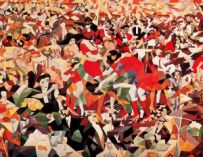Definition – Futurism
Futurism, in Italian Futurismo, in Russian Futurism, was an early twentieth-century artistic movement that was based mainly in Italy and emphasized the technology, speed, energy, and power of the machine and the vitality, change, and restlessness of modern life. It wasn’t just an artistic movement, it also influenced poetry. It was a backlash against the nineteenth century.
The movement was at its strongest from the year 1909, and diminished after 1918. It was in 1909 that Filippo Marinetti‘s first Futurism manifesto appeared. Futurism was a self-invented art movement. It also favoured the advancement of Fascism.
The Futurists loved to publish manifestos and they (usually led or prompted by Marinetti) wrote them on many topics, including painting, architecture, religion, clothing and cooking. Futurism had from the outset admired violence and was intensely patriotic.
Futurism was actually inspired by the growth of the Cubist movement but aimed to move beyond its techniques. The Futurists made rhythm with a repetition of lines. They broke up motion into small sequences, using a wide range of angles, within a given time frame. They wanted to incorporate the dimension of time within a painting. Lavish colours and flowing brush strokes added to the idea of movement.
Key Artists
Umberto Boccioni – Boccioni is arguably the most famous Italian Futurist. He trained from 1898 to 1902 in the studio of the painter Giacomo Ball, where he learned to paint in a Pointillist style. In 1907 he settled in Milan and became influenced by Marinetti. Boccioni became a leading theoretician of Futurist art. He helped draw up and publish the Futurist Manifesto. This painting below is a perfect example of Futurist painting in its representation of dynamism, motion, and speed. The swirling human figures are repetitively fragmented complying with the Futurist style.
Giacomo Balla – Balla was another key artist who came to adopt the style of Futurism in his art, with an interest in depicting light, movement and speed. He was a major signatory to the Futurist Manifesto and began designing and painting Futurist furniture and also created Futurist ‘antineutral’ clothing. He also taught Umberto Boccioni.
Gino Severini – another Italian painter but also mosaicist, stage designer and writer. he was one of the principal exponents of Futurism, and he provided an important link between Italian and French art. He had quite a long career but his most significant works came before World War I.
Carlo Carra – Carra was another leading figure of the Futurist movement. He signed the Futurist manifesto along with Boccioni, Luigi Russolo and Marinetti. It was during his period as a Futurist that he produced some of his best known paintings.
One Key Work
I found it hard to pick one key work so I chose one that seemed to represent many different elements of the Futurist movement, such as capturing movement, time, speed, dynamism, colour, and line, and that is Simultaneous Visions by Umberto Boccioni. This picture is so colouful and busy. It is almost science fiction.
References:
WebMuseum, Paris, http://www.ibiblio.org/wm/paint/glo/futurism/ [last accessed 12 November 2012]
Wikipedia on Futurism, http://en.wikipedia.org/wiki/Futurism [last accessed 12 November 2012]
Encyclopedia Brittanica on Boccioni, http://www.britannica.com/EBchecked/topic/70885/Umberto-Boccioni [last accessed 12 November 2012]
Wikipedia on Balla, http://en.wikipedia.org/wiki/Giacomo_Balla [last accessed 12 November 2012]






You missed out my favourite ism: Vorticism – a rather British blend of Futurism and Cubism: e.g. http://www.flickr.com/photos/32357038@N08/3689947919/ or http://www.flickr.com/photos/32357038@N08/3598176034/ or
http://www.flickr.com/photos/32357038@N08/4484643375/
Thanks for pointing me in the direction of a fascinating ism I never knew existed.
My Art History ‘A’ Level wasn’t a complete waste of time! 🙂